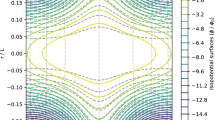Abstract
IN the Journalde Physique et le Radium for April 1928, Prof. N. Minorsky describes observations he has made on the behaviour of a mercury arc in a magnetic field under low gas pressure. Under certain experimental conditions he found that the arc moved in a direction opposite to that which should be expected from the electrodynamical laws governing the movement of a conductor carrying current in a magnetic field, and proposes a space charge theory to explain this phenomenon. His theory is based upon the assumption that by the combined effects of collisions and the magnetic field, the electrons in the arc-stream are made to travel in the electrodynamic sense around the annular space in which his arc is drawn, and will thereby establish a negative space charge on the opposite side of the arc. The action of this space charge on the positive ions of the arc is assumed to cause the arc to move in the direction observed. It will be realised that this theory requires a circular or at least a closed path for the arc to move along.
This is a preview of subscription content, access via your institution
Access options
Subscribe to this journal
Receive 51 print issues and online access
$199.00 per year
only $3.90 per issue
Buy this article
- Purchase on Springer Link
- Instant access to full article PDF
Prices may be subject to local taxes which are calculated during checkout
Similar content being viewed by others
Author information
Authors and Affiliations
Rights and permissions
About this article
Cite this article
TANBERG, R. Motion of an Electric Arc in a Magnetic Field under Low Gas Pressure. Nature 124, 371–372 (1929). https://doi.org/10.1038/124371a0
Issue Date:
DOI: https://doi.org/10.1038/124371a0
This article is cited by
-
Das Verhalten des Lichtbogens im transversalen Magnetfeld
Archiv f�r Elektrotechnik (1957)
Comments
By submitting a comment you agree to abide by our Terms and Community Guidelines. If you find something abusive or that does not comply with our terms or guidelines please flag it as inappropriate.



